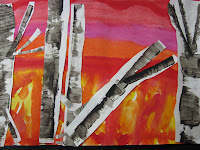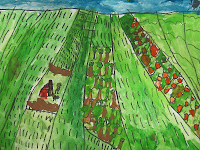Third grade students looked at artwork by Pablo Picasso and read a book about his life. They learned that Picasso could paint realistically, but chose not to. They learned that Picasso was the inventor of cubism, and painted many of his artworks with shapes such as squares and rectangles. Students learned that many people didn’t like his artwork at first, but now it is some of the most famous artwork in the world. Students drew a cubist portrait and painted it with tempera paints.

Los estudiantes de tercer grado miraron obras de arte por Pablo Picasso y leyeron un libro sobre su vida. Ellos aprendieron que Picasso sabía pintar realísticamente, pero escogió no hacerlo. Ellos aprendieron que Picasso fue el inventor del cubismo, y pinto muchas de sus obras con figuras como cuadrados y rectángulos. Los estudiantes aprendieron que a muchas personas no les gustaron sus obras al principio, pero ahora son de las obras de arte más famosas del mundo. Los estudiantes dibujaron un retrato cubista y lo pintaron con tempera.





















































